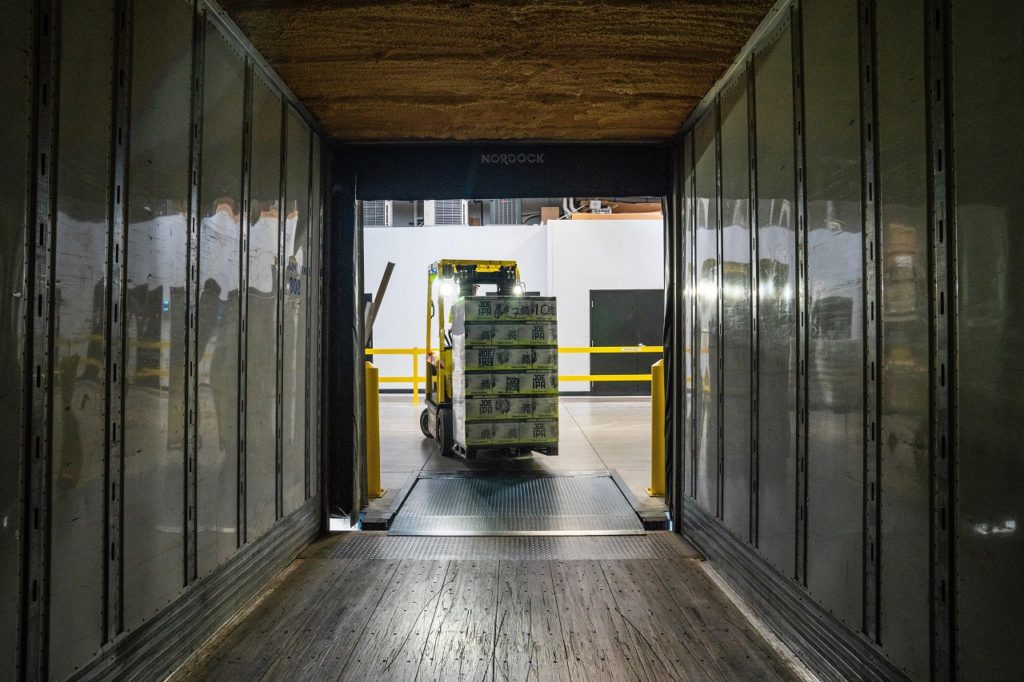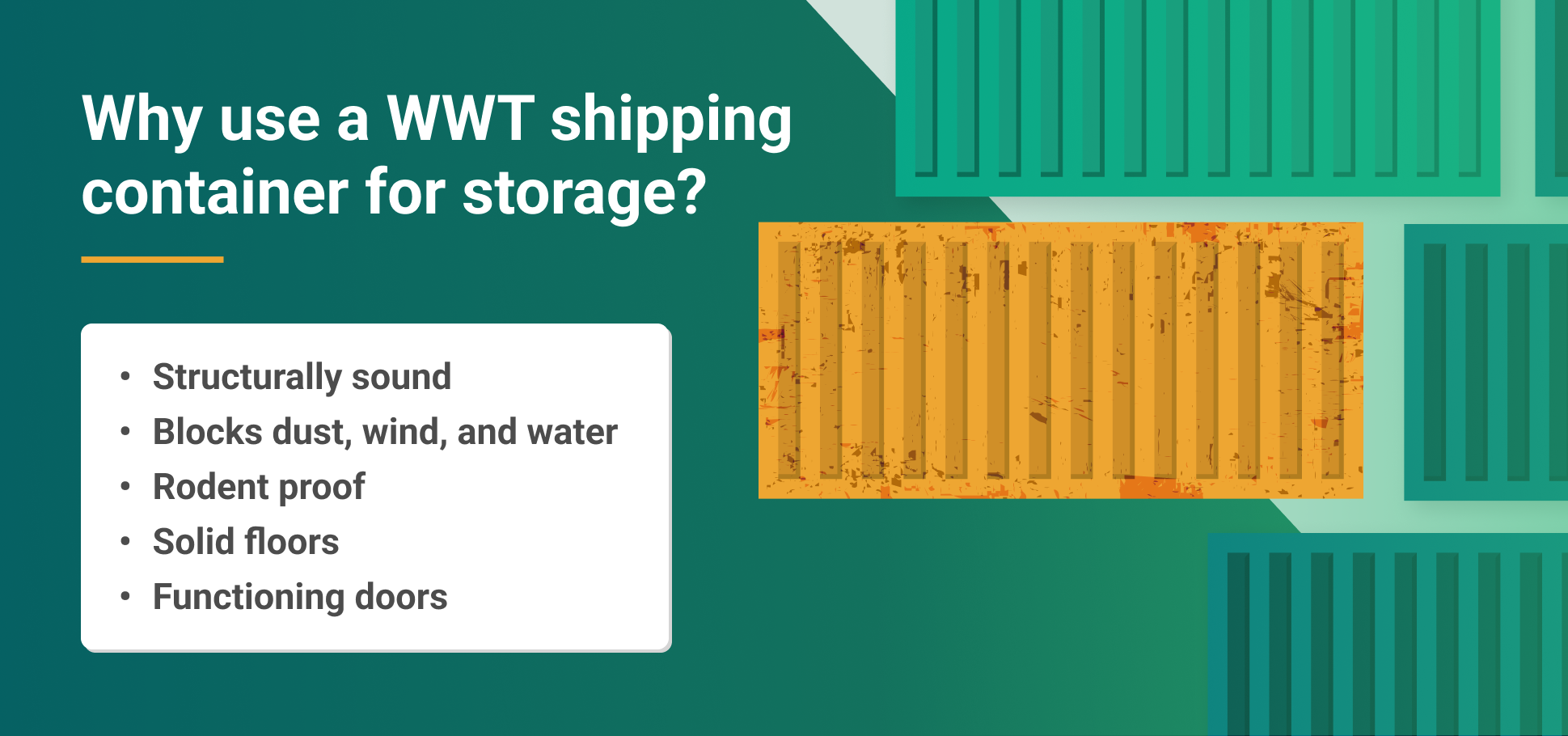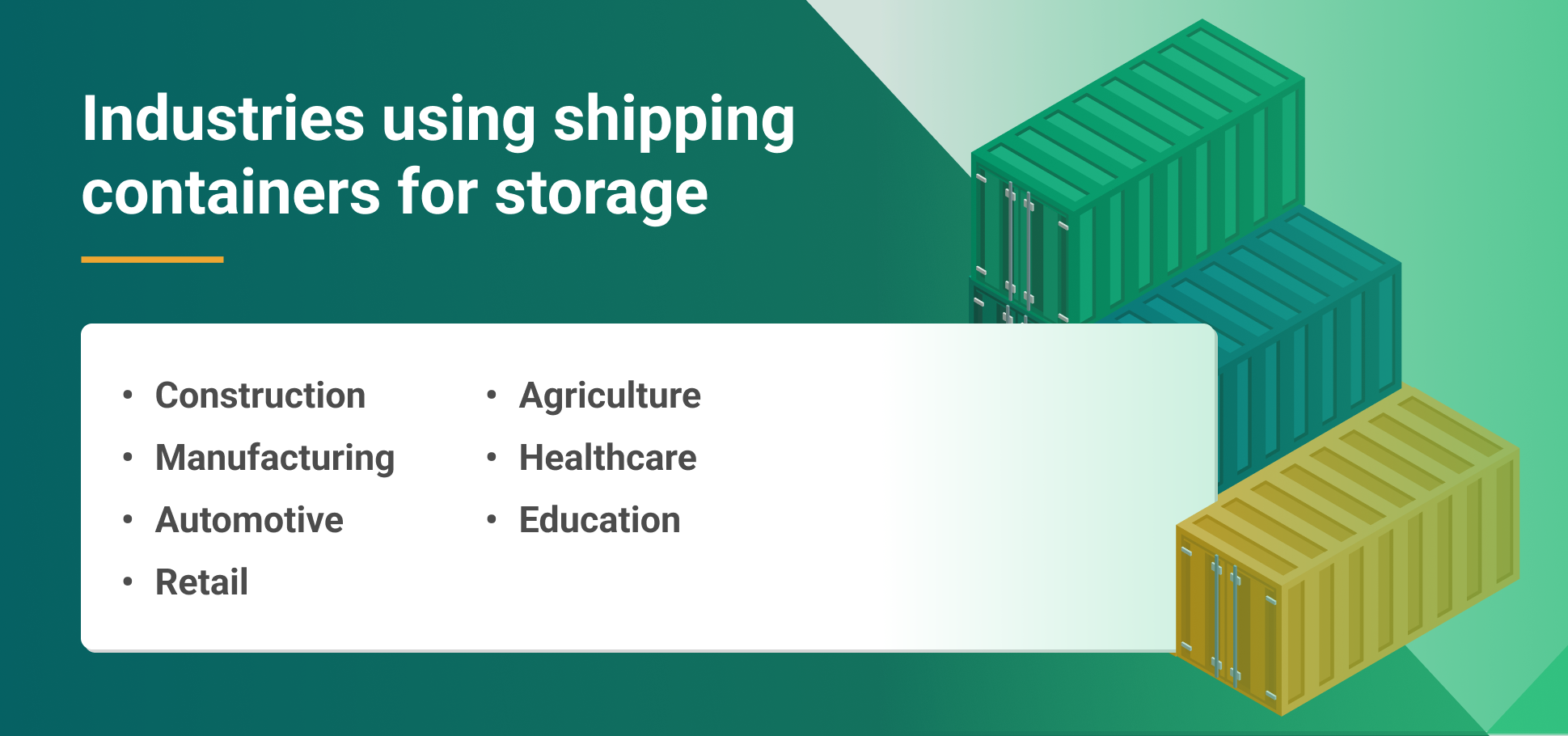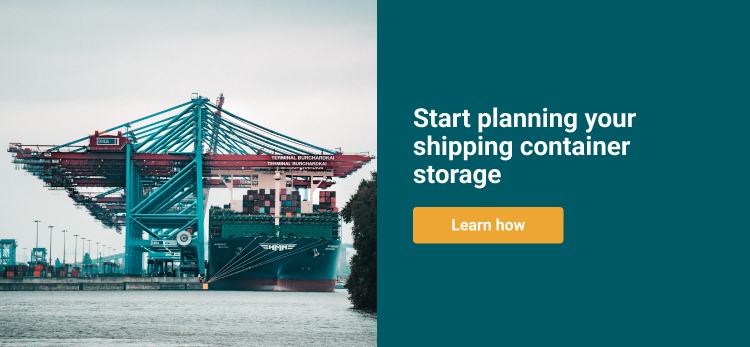Transportation and warehousing draw a big part of a company’s logistics budget. With the increase in fuel and real-estate prices, it gets difficult for businesses to plan their supply chain. If you’re looking for a cost-effective solution, this blog on shipping container storage might actually save you money.
You’d be surprised to know that shipping containers are in high demand for not just shipping. Shipping containers make excellent storage units. The durable boxes, made to withstand rough seas, keep your inventory safe and secured. If required, you can also move these storage units by the usual modes of shipping.
To put it simply, shipping containers function as portable warehouses. If you buy a container for storage, you end up saving money on warehouse rent and transportation of your inventory. It’s definitely one of the most practical ways of reducing your costs in the long-run.
Are you ready to make that power move for your business? Use our public search to find shipping containers for your storage needs. Select the location and your preferred type of container to find matching deals today!
Should you lease or buy your storage shipping container?

This question is the most important and practical query to have. And, the answer depends on what your requirements are.
You should lease if you want storage for a limited duration. If you need to temporarily store your inventory for a particular season, or a few months, you should opt for leasing the containers. This way, you’ll avoid the hassle of maintenance, and you can simply return the container after using it.
You should buy shipping containers if you want storage for a long duration. It’s best to do a cost-benefit analysis for renting versus buying containers. For long-term use, the cost of buying a container becomes cheaper than renting it for a long time. Plus, you can earn extra income by selling or leasing containers after using them for storage.
Are you ready to get your hands on a storage container? Then Container xChange can help you save both time and money. On xChange, you can find best deals on containers of your requirement.
At our online marketplace, you can find different equipment types from 800+ vetted partners globally — without paying any commission. Want to see it for yourself? Click on the banner below!
What’s the difference between storage shipping containers and other containers?
There are several different kinds of containers available in the market today. If you’ve searched online, you’ve likely encountered three main types of containers: shipping, storage, and CONEX. Let’s briefly understand the differences and similarities between them.
Shipping containers
As the name suggests, shipping containers transport cargo via ships, trains, and trucks. They’re available in standardized sizes of 20ft and 40ft. Made from highly durable and corrugated steel, the average lifespan of shipping containers is 15 to 18 years.
Storage containers
Storage containers refer to shipping containers mainly used for storage purposes. There are several specialized storage containers in the market today. You can find them in different sizes and lightweight materials.
CONEX containers
CONEX is an abbreviation of Container Express. Invented during the Korean War, these units have evolved to become modular intermodal storage units that can be easily stacked together. Want to know more about CONEX containers? Click here.
Benefits of shipping container storage
Every smart decision you make will give you a competitive advantage. If you’re wondering why businesses and companies are using shipping containers for storage, then the answer is simple — to save money on real estate and transportation costs.

Let’s have a look at some of the benefits of shipping container storage through an example:
Inventory can be stored closer to where needed
Let’s assume you own a mid-size coffee business in Berlin. Your shipment of coffee beans has just arrived from Colombia to the Hamburg port, and they have to be moved to your processing unit in Berlin.
Since you own a mid-size business, arranging for a warehouse in Berlin might not be a financially viable decision for you. At this point, you can repurpose the shipping container as a storage unit at your processing unit. This way, you get to store your inventory closer to where you need it without shelling money on expensive storage warehouses.
Immediate storage
Since you own the container, you won’t have to deal with the hassle of finding and leasing a warehouse for coffee beans. You can save costs and time by simply using the shipping container as your storage space.
Long-term storage with the same footprint
Likely, your processing unit in Berlin isn’t spacious enough to accommodate more than two shipping containers. In such a situation, you can simply build your shipping container storage unit vertically by stacking containers on top of each other. It’ll save you both real-estate and transportation costs.
Steel protects inventory from seasonal changes
It’s widely known that weather changes can impact the texture and taste of coffee. As a businessperson, you need to ensure that your raw material is safe from external changes. You can do so by using sturdy containers made out of high-grade steel that safeguards against weather changes.
Portable Unit
After the coffee beans are processed and packed, you’ll now need to ship the coffee to cafes in and around Germany. Since you already have the shipping containers, you can easily use them for transporting your goods. These portable storage units can easily be moved around via sea, rail, and road.
Can be customized
Now, let’s assume your business has expanded, and you’re selling coffee machines. The storage requirements of coffee machines would be different from that of coffee beans. For this, you can easily customize the container by installing racks and shelves against the container walls. Since you own the shipping containers, you can customize them according to your needs.
Should you buy a new or used container?

The second most important and practical question to ask yourself is whether you need a new or a used shipping container for storage. Scroll down to learn about the pros and cons of the two conditions.
New Shipping Container
New containers offer the best long-term value. Even though they’ll be significantly more expensive than the used ones, new shipping containers can easily last decades.
A container gains damage during rough handling and movement. But since you’ll keep the storage shipping container static at one place, the lifespan will easily increase from 15-18 years to several decades. It’s very likely that even after decades of use, your container would be better than the average used boxes.
Wind and Water Tight Shipping Container (WWT)
WWT containers are mostly in demand for storage. WWT containers refer to used shipping containers in which no wind or water can get through. Usually, 10-15 years old, WWT containers report damage only with minor dents and rust. With additional 5-7 years of lifespan, WWT containers are in perfect condition to protect your inventory from water, weather, rodents, and theft. Learn more about WWT containers by clicking here.

Are you wondering where you can get new and WWT containers for storage? At xChange, you can find containers in both conditions from sellers across the globe. Just select your preferred container type and condition, and get deals with the best prices. Click on the banner to get started today!
Types of containers used for shipping container storage
The third most important question you’ll be asking in the process of buying a storage container is what type of equipment will suit your inventory the best. Is your inventory dry? How many times do you need to access the storage unit? Do you need to maintain a certain temperature?
For dry storage
If your dry inventory doesn’t need specialized care, you can opt for standard dry cargo (DC) containers. DC containers come in 20ft and 40ft sizes and are easily available for sale. You can also select 40ft high cube (HC) containers for more storage space. These containers are airtight and water-resistant, keeping your inventory safe.
For multiple points of access
If you need access for loading and unloading regularly, then having multiple doors to your storage unit can fasten your process. You can opt for double door and side door containers. Also referred to as a tunnel container, the double door has doors on both ends of the container. The side door container has doors on one end and one side.
Find Double Door & Side Door Containers
For temperature control
Your inventory might need to be stored at low temperatures. For this, you can opt for reefer containers. Reefers are essentially container-sized refrigerators used to move food items and temperature-sensitive goods. They can maintain any temperature between -30°C and +30°C.
Shipping container storage dimensions
The storage shipping containers have the same dimensions and volumes as normal shipping containers. However, the capacity of the containers can vary from manufacturer to manufacturer.
Below are the dimensions of 20ft , 40ft , and 40ft HC storage shipping containers.
| Measure | 20ft | 40ft | 40ft HC |
| Internal length | 5.9m / 19.4ft | 12.03m / 39.5ft | 12.03m/39.5ft |
| Internal width | 2.35m / 7.8ft | 2.4m / 7.9ft | 2.35m / 7.8ft |
| Internal height | 2.39m / 7.9ft | 2.39m / 7.9ft | 2.70m / 8.10ft |
| Tare weight | 2,300kg / 5,071.5 lbs | 3,750kg / 8,268.8 lbs | 3,900kg / 8,598 lbs |
| Payload capacity | 25,000 kg / 55,126.9 lbs | 27,600kg / 61,200 lbs | 28,600 kg / 63,052 lbs |
| Cubic capacity | 33.2 m³ / 1,172 cu ft | 67.7 m³ / 2,389 cu ft | 76.3 m³ / 2,694.5 cu ft |
Industries making use of shipping container storage
We’ve been talking about how using shipping containers storage can give you a competitive advantage. Now, it’s only fair to wonder how several industries are using them to become more efficient.

Construction
To store expensive building materials at construction sites. Unlike traditional sheds, shipping containers are sturdier, safer, and air and water-tight.
Manufacturing
To store raw-materials and final products. The same storage shipping containers are also then used to ship the products.
Automotive
To scale-up their inventory and store spare parts. The storage shipping containers are used to ship the automobiles to showrooms, and other places.
Retail
To segregate and store different products in an organized way. Customized shipping containers are perfect for storing retail products such as electronics, eatables, clothing, etc.
Agriculture
To store food grains and keep heavy machinery safe. Many farmers are now growing plants vertically in shipping containers rather than farmlands, as they can easily monitor moisture, temperature, and sunlight.
Healthcare
To use containers as make-shift hospitals in remote places. The shipping containers are also used for storing chemicals and other pharmaceuticals.
Storage shipping containers for sale on xChange
Now that you have an overall picture on shipping container storage, it’s time to make a move. Scale your business by saving costs on real estate and transportation. If you’re wondering where to start, we’ve got you covered at xChange.
Every month, we have over 10,000 transactions on our online marketplace across container types and categories. You can browse through the offers by vetted sellers to find the right container at the right price. And you can do this without paying us a commission!
Want to see how easy it is to find the right shipping container for storage using xChange? Click on the banner below and book a free 15-minute call with our team. They’ll show you how you can find your next containers quickly, easily, and safely.
How much does it cost to store a shipping container?
If you are leasing, then the cost of storing a shipping container depends upon your rental agreement. If you’re buying the container for storage, then the amount you need to pay is the buying price, transportation cost, and taxes (if applicable).
Do shipping containers make good storage?
Shipping containers make excellent storage units. The durable boxes, made out of corrugated steel, keep inventory safe and secured. They can also be transported by the usual modes of shipping.
How much does a 40ft container cost?
A brand new 40ft container costs around $4,000 to $5,800. A cargo-worthy 40ft container costs around $2,200 to $4,800. The price varies globally according to container availability.
How to use a shipping container for storage?
A shipping container can be used for storing your surplus stock, inventory, raw materials, and spare parts. You can simply buy or lease the containers, move them to your premises, and use them for storage.
What can you not store in a shipping container?
You cannot store toxic and hazardous materials in a shipping container. Do not store perishable food items, plants and animals, weaponry, and valuables, among other things.






